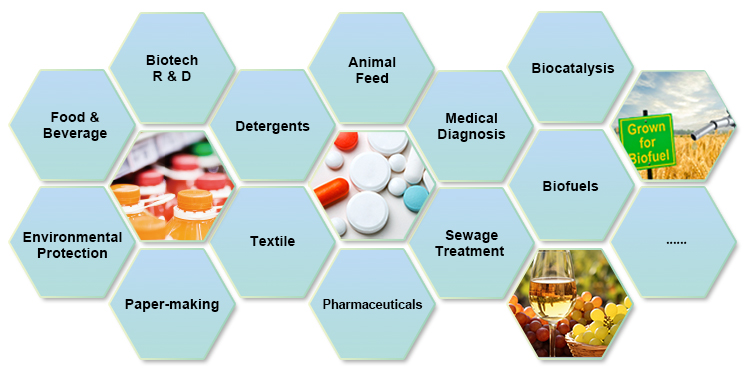Enzymes, nature’s meticulous catalysts, drive life’s processes with astounding efficiency and specificity. Beyond being vital for life, they harbor immense potential across various fields, including industry and medicine. The ongoing advancements in enzyme engineering, aimed at enhancing their efficiency, specificity, and stability, are unlocking boundless possibilities in the realm of biocatalysis.
Harnessing the Power of Enzyme Engineering: A Triad of Improvement, Optimization, and Design
Enzyme engineering endeavors to modify enzymes, making them more apt for specific applications by utilizing genetic engineering and molecular biology techniques. The objectives of enzyme engineering encompass:
- Improving Catalytic Activity: Elevating enzyme efficiency by modifying its amino acid sequence, structure, or catalytic site, thereby reducing reaction time and energy consumption.
- Enhancing Specificity: Adjusting the enzyme’s substrate selectivity to target specific substrates with higher precision and minimize undesired side reactions.
- Boosting Stability: Modifying the enzyme’s structure to augment thermal stability and introducing specific alterations to enhance its resilience.
- Mitigating Inhibition & Inactivation: Lowering the risk of inhibition or inactivation by reducing the enzyme’s sensitivity to inhibitors.
- Designing Novel Catalytic Functions: Reconstructing enzymes or synthesizing new proteases to facilitate catalysis of specific, including unnatural, reactions.
Accelerating Development through Multifaceted Advantages
- Increased Efficiency: Enhanced catalytic activity and substrate specificity boost reaction efficiency, minimize waste, and curtail production costs.
- Customization: Enzymes can be tailored to meet specific applications and requirements, offering highly personalized solutions.
- Sustainability: Enables the transformation of biomass resources into renewable energy or valuable chemicals.
- Cost Reduction: Augments the efficiency and stability of the enzyme, thereby enhancing the economic feasibility of the production process.
- Eco-Friendly: Minimizes the production of hazardous chemical waste, assists in decomposing organic waste and pollutants, improves water quality, and mitigates environmental impact.
Innovative Development through Multifaceted Breakthroughs
Enzyme engineering plays a pivotal role across various fields, enhancing productivity, product quality, and environmental sustainability. Its potential, however, transcends these domains, with numerous unexplored areas ripe for exploration and development.

Navigating through Multiple Remodeling Methods
The strategies, whether utilized independently or in tandem, are contingent upon the nature, objectives, and resources available for the project. Enzyme engineering is continuously evolving, with new strategies emerging to navigate diverse challenges. Selecting the apt strategy is contingent upon understanding the target enzyme and project requirements to realize optimal enhancements.
| Site-Directed Mutagenesis | Random Mutagenesis | Directed Evolution | Protein Engineering | Rational Design | |
|---|---|---|---|---|---|
| Feature | Targeted alteration of specific amino acid sequences | Introduces a large number of random variants | Requires continuous screening and iteration | Alter protein properties and structure | Enzyme-based structural and computational simulations to predict and design potentially improved variants |
| Application | For enzyme structures and functions that are known to precisely improve specific properties (e.g., increase catalytic efficiency, change substrate specificity) | For enzymes that require extensive mutation to discover new properties or improve specific properties | For unknown enzymes or where extensive mutations are needed to improve multiple properties | For a wide range of enzyme performance improvement needs (e.g., fusion labeling, structural modification, etc.) | For known enzyme structures and need for precise improvement |
| Advantages |
|
|
|
|
|
| Limitations |
|
|
|
|
|
Comprehensive Research Strategies:
-
Protein Design:
- Structure-guided Protein Design
- Library Design
- NG Codon Optimization
-
Gene Synthesis & Library Construction:
- Syno GS Gene Synthesis Platform
- Syno HT High-Throughput Gene Synthesis Platform
- Library Construction Platform
-
Verification and Analysis:
- Sanger Sequencing
- NGS Verification
- Library Colony Size >100X, Accuracy can up to 90%, Uniformity Index <10
-
Function Verification:
- Protein Expression Platform
- Candidate Strain and Protein Screening
- Enzyme Activity Verification and Analysis
- Scaled Production
The unification of synthetic biology with enzyme design is set to amplify the efficiency and sustainability of enzyme engineering. Enzyme engineering will be instrumental in sustainable production and ecological conservation, crafting a greener and more sustainable future for all.
Synbio Technologies, with its team of seasoned experts in protein engineering and library construction research, offers a plethora of solutions for targeted protein evolution, including site-directed mutagenesis, random mutant libraries, site saturation libraries, and controlled libraries. Explore our professional and cost-effective enzyme engineering solutions today!
References:
Sharma, A., et al. (2021). Enzyme engineering: current trends and future perspectives. Food Reviews International, 37(2), 121-154.
Victorino da Silva Amatto, I., et al. (2022). Enzyme engineering and its industrial applications. Biotechnology and Applied Biochemistry, 69(2), 389-409.
Mazurenko, S., Prokop, Z., & Damborsky, J. (2019). Machine learning in enzyme engineering. ACS Catalysis, 10(2), 1210-1223.
 DNA Synthesis
DNA Synthesis Vector Selection
Vector Selection Molecular Biology
Molecular Biology Oligo Synthesis
Oligo Synthesis RNA Synthesis
RNA Synthesis Variant Libraries
Variant Libraries Genome KO Library
Genome KO Library Oligo Pools
Oligo Pools Virus Packaging
Virus Packaging Gene Editing
Gene Editing Protein Expression
Protein Expression Antibody Services
Antibody Services Peptide Services
Peptide Services DNA Data Storage
DNA Data Storage Standard Oligo
Standard Oligo Standard Genome KO Libraries
Standard Genome KO Libraries Standard Genome Editing Plasmid
Standard Genome Editing Plasmid ProXpress
ProXpress Protein Products
Protein Products
























